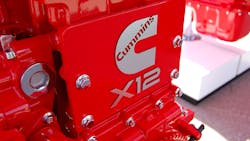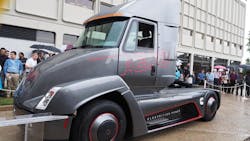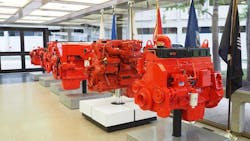COLUMBUS, IN. With about 42,000 of Cummins, Inc.'s latest big-bore X15 Series diesel engines produced since their launch in January, the company unveiled the 15L platform's next evolution slated for availability in 2022 and showcased a range of energy-diverse products, including a fully electric, plug-in Class 7 truck.
The press event at Cummins Technical Center here in Columbus, the company's global headquarters, explored how the engine maker is positioning itself to be the supplier of choice across the spectrum of diesel, alternative and emerging engine and powertrain technologies for commercial vehicles. "We're ready to support the changes shaped by the regulatory environment and global concern for air quality and the need for a low-carbon future," said Jennifer Rumsey, vice president and chief technology officer at Cummins.
That includes heavy duty diesel engines the company said will meet tightening emissions and efficiency requirements going forward. With the 2017 X15 weighing in at 2,950 lbs., the next iteration of the engine is going to shave off some 300 lbs. from that and has essentially been designed to fit into a 13L engine's "shell," engineers explained. Reporters got a glimpse of the new engine in prototype form.
The goal is to deliver a 15L for 2022 that's capable of the same levels of horsepower, torque and durability but will weigh less and have a smaller footprint to allow for advanced fuel systems, emissions and after-treatment technology and placement — as well as being able to fit in new aerodynamic truck designs.
The upcoming Cummins X12 12L diesel, geared toward regional haul and weight-sensitive vocational trucking applications, will arrive in March 2018. It'll be available with ratings of 350-475 hp/ 1,250-1,700 lbs.-ft. of torque but weighs only about 2,050 lbs., which Cummins engineers said is roughly 600 lbs. lighter than the nearest 13L competitor and 150 lbs. lighter than even the nearest 11L competitor.
The coming X12 and current and next-gen X15 engines utilize Cummins compact Single Module Aftertreatment product. They also share parts such as oil filters and turbos to help reduce costs for fleets with a mix of vehicles and configurations.
Brett Merritt, executive director for on-highway business at Cummins, stressed the company's technical expertise and highlighted its wide product portfolio, noting the company is investing $700 million annually around the world in research and development.
"We have the largest on-highway product offering in the globe. From 2.8L to 15L, from natural gas to diesel, we offer a wide array of solutions for our customers," he said. According to Merritt, Cummins' 2017 engine lineup has helped it reach an 80% share of the medium-duty North American commercial truck market, largely thanks to the B6.7 and L9 engines.
"Whether the application be RV, package van, fire truck or bus, people in the market are choosing Cummins," Merritt said. "This suite of engines has become near-ubiquitous in the bus market, both transit and school, where we've reached over 90% share." Meanwhile, Cummins claims more than 37% market share in powering North American Class 8 trucks, a market to which the company remains "absolutely committed," he added.
Alternatives and advancements
Although Cummins believes diesel will remain the power source of choice for North American trucking for decades to come, the company is continuing to develop and invest in alternative fuel engines and technologies. It will also offer integrated powertrain solutions through its recently formed Eaton Cummins Automated Transmission Technologies joint venture.
Stealing the show at the press event Tuesday was Cummins' "sneak peek" at the AEOS, a fully electric Class 7 demonstration truck with a max GVWR of 75,000 lbs. and a range of 100 miles per charge, which is extendable to 300 miles with additional battery modules. The truck features a Cummins Integrated Electrified Powertrain ahead of the company's 2019 target for market availability of such an electric option.
Cummins also showcased its development of a high-efficiency spark-ignited technology "that can deliver diesel-like performance and durability" across a range of liquid fuels from ethanol to methanol and gasoline and can meet "the most stringent emissions requirements." At the Columbus technical facility, Cummins operates 88 test cells running diesel, natural gas, gasoline, ethanol, hydrogen, propane and biodiesel engines and has also invested in and continues to explore fuel cell power.
Rob Neitzke, president of the Cummins Westport Inc. joint venture producing natural gas engines, pointed out that the latest Near-Zero 2018 powerplants — the B6.7N, L9N and ISX12N — are certified to the California Air Resources Board's NOx emission standards that are 90% lower than those of the U.S. Environmental Protection Agency.
He stressed the maturity of CNG technology as a fiscally viable option for the right markets and stability of natural gas prices, noting that fleets can purchase 3-4 year futures of the fuel.
Connectivity
The array of fuel and engine/powertrain options comes together with Cummins application of connectivity and data analytics. To that effect, Cummins formed a new internal organization in May led by Sherry Aaholm, chief information officer at Cummins, called the Digital Accelerator.
It's meant to streamline innovation and bring concepts from idea to commercialization faster and complements Cummins' Connectivity Solutions division formed 15 years ago.
Srikanth Padmanabhan, president of engine business at Cummins, explained that the point of the company's energy diversification in terms of commercial powertrains is to capitalize on disruptions globally while offering power solutions custom-tailored for individual markets and customers.
"We will be the powertrain provider of choice for our customers, regardless of what the powertrain choice is in the on- and off-highway world," he contended. "Connectivity and electrification as disruptions are here — and we will capitalize on those disruptions much as we have with the other disruptions over the last few decades."
Further, "we've succeeded in disruption because Cummins is a technology company that embraces change and capitalizes on that change with the right technology that matters for the marketplace and our customers," Padmanabhan said.
Whatever the fuel for commercial vehicles, Cummins sees a unifying factor in data and computer control. That will allow the company to send over-the-air updates to reconfigure powertrains based on customers' particular needs, for example, while bringing maintenance to the prognostic and proactive.
"We are able to start to see patterns that emerge, and out of those patterns we able to take care of reactive solutions for our customers in a shorter and shorter time frame," Padmanabhan noted. "But more importantly, we are thinking about them in a prognostic way and a proactive way and can help our customers fix the problems that they should never have in the first place."
Going forward, Cummins sees a mix of internal combustion engines using a variety of fuels that will be necessary in the decades to come to meet commercial vehicle needs. But there will also be a variety of electric power based on geography, range/duty cycle and regulatory requirements, Padmanabhan contended, including fully electric, range-extended electric and hybrid electric configurations.
And Cummins is hoping its global reach and established relationships will give it an edge in providing that range of power and powertrain options. "We're the people that understand the industry, that know the marketplace and know the customer applications," he said. "Whatever is going to come in the next 15 years, we will do the right thing in terms of making sure that the right technology for our customers matters, not just technology for the sake of technology."
About the Author
Aaron Marsh
Aaron Marsh is a former senior editor of FleetOwner, who wrote for the publication from 2015 to 2019.




